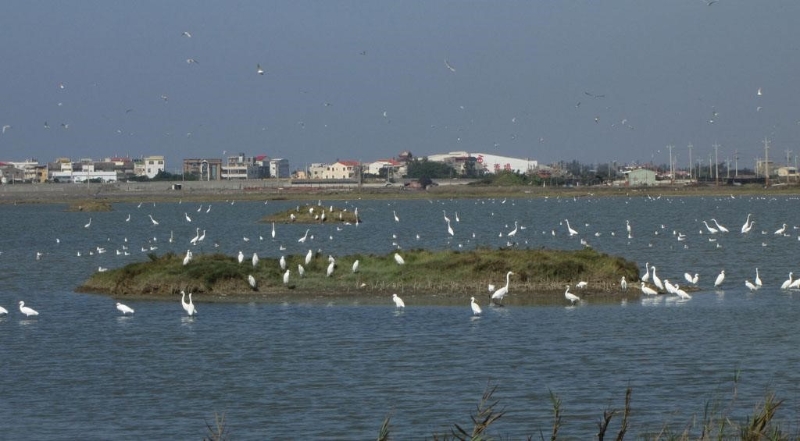對話之後:一個生態藝術行動的探索
周靈芝
此一研究是一趟穿越時空的旅行,源起於2008年在嘉義縣北回歸線環境藝術行動所舉辦的「蚵貝地景藝術論壇」── 一個打算以廢棄蚵殼進行地景藝術創作的計畫,及其後續發展。本文作者藉由回溯當年參與者的對話發言,以及論壇結果,透過訪談、文獻分析和參與觀察,鋪陳出一場人與環境新關係的建構,正在台灣西南沿海低地安靜的展開。
全文共分為八章,分別探討了從「對話作為一種藝術的形式」出發,回顧蚵貝地景藝術論壇舉行的背景與過程;英國藝術家大衛黑利在論壇中提出「與蚵對話:協力的藝術」的角色;以及論壇的組成成份和議題關注面向的演變,也就是透過「對話」,發現對蚵殼及廢棄鹽灘的價值觀改變了,和提升到全球氣候變遷的高度來看地方所面對的環境議題; 並進一步分析當時所提出的藝術創作方案和其基地環境的關係,與可再補充之處。
接著,將上述討論置回到更寬廣的時空脈絡之中,透過對台灣地理、地質、考古和歷史學者研究成果的整理,從放大的時間尺度去理解台灣西南海岸所面對的環境變遷,包括曾因氣候變遷、全球暖化所帶來的海水上升;颱風暴潮所帶來的海岸侵蝕與河流輸沙對沿岸沙洲的影響;以及人為介入後導致原本的地形結構被破壞,出現不一樣的作用力,在不同地帶因土地利用的方式而帶來的後果,例如:上游截水、建水庫、蓋攔沙壩;中下游建河堤,約束水流;以及沿海地帶因抽沙填陸,造海埔新生地,以致沙源流失、海水入侵,海岸防風林消失(枯死);突堤效應則帶來另一個沿海地帶地形變遷的因素。另外就是養殖漁業因淡水需求抽取地下水,而中上游補注水不足,也造成地層下陷,海水再入侵的惡性循環。氣候變遷則會使以上所面對的環境挑戰更加劇烈。
面對這樣的挑戰,台大城鄉基金會資深規劃師,也是蚵貝地景藝術論壇召集人蔡福昌,在雲嘉南國家風景區管理處和嘉義縣政府的委託下,延續著論壇中所開啟的多元對話,展開了在嘉義縣海岸地區的深度調查,包括水文、生態、社區、文史、產業等面向,並進行全區發展規劃。調查結果發現,鹽田廢曬之後,經過自然演替,不但成為生態豐富的海岸濕地,而且有大量鳥類來此棲息,其中甚至包括列入瀕危等級的國際保育鳥種黑面琵鷺。原來被視為荒蕪之地的廢棄鹽灘,竟然成為鳥類棲息的濕地天堂。因此在區域規劃方面,蔡福昌和台大城鄉基金會的團隊採取了生物圈保留區的理念,以物種保育為優先,尊重原有的地形、地貌為基礎,同時衡量其規劃範圍內環境資源條件、地點區位、交通動線和設施現況等因素綜合評估後,建議將整個規劃範圍區分為五大主題分區,做為未來濕地改善復育的空間治理架構。從分區發展的規劃全圖看來,除了以生態復育為目標的生態棲地復育區和生態魚塭放養區之外,氣候變遷環境體驗學習區也佔有相當重要的比例。換句話說,在南布袋濕地復育計畫中,生態復育和氣候變遷是兩個極具核心價值的概念。而藝術,則被賦予了行動的媒介此一角色,「藉由多元參與式行動計畫的介入,集體拼貼與共創濕地復育地景。」
在操作面上,台大城鄉基金會工作團隊以所謂「滾動式綜合治理策略」進行實踐,亦即透過延展時間的軸線,「在現階段優先啟動先導性行動方案,待於變動中與自然環境互動一段時間與反省評估後,再研擬下一階段的實施項目,並據此調整或修正下一階段的願景和目標。」所謂的先導計畫,包括了濕地生態環境的各項學習工作坊,透過駐村協力,期待能「培力氣候變遷時代的低碳綠色公民,培養原創學習能力」,以及「強化在地參與機制,連結學校、教育機構、社區、民間組織和專業者(機構)等之跨領域協力伙伴關係和專業支援網絡,厚實永續經營基石。」涉及的項目有:地理變遷和生態復育、綠色能源、海岸造林、未來挑戰、產業及環境教育等。其中,產業所關切的糧食問題和能源項的風力發電,以及未來挑戰中的水資源議題,是關係到在地生活極其基本的需求,而在地理變遷和生態復育,以及海岸造林和環境教育方面,則是關乎到環境的維護,並且讓不同的藝術方法整合進來,成為最佳的民眾溝通、宣導的策略。
2012年蔡福昌提出「濕地糧倉」的概念,涵蓋了從過去到未來的地景變遷、候鳥棲地保護、漁鹽產業文化活化、地層下陷和低地聚落轉型發展等議題,並進一步提出「以文化多樣性來復育生物多樣性」的說法,呼應了先前大衛黑利所提出的「積極的生活本身便是社區/社群的藝術。這種積極性在社區/社群中是個不斷進行的過程,而這過程也才能回應地景、地貌乃至海岸地區的變遷。」
最後,本文作者探討了「地方參與」與「在地組織」在整個過程中所扮演的角色,以及國家政策對在地議題的衝擊,特別是身為雲嘉南沿海廣闊海岸濕地重要主管機關的雲嘉南國家風景區管理處,在歷任首長的人事更迭之後,不再把國土復育、保育及教育視為份內工作,也缺乏國土整合性運用的思考和作法,而以觀光獨霸的思維取代。一連串打著裝置藝術名號的工程,正在沿著雲嘉南的海岸線上出現,既非藝術,也沒有環境思維。然而因其挾著龐大國家資本,即使備受爭議,仍然未停下腳步。這不僅擠壓到原本資源即有限的在地耕耘,更無視於該地區所面對的未來挑戰。這樣的做法實在令人遺憾。
(English version)
This research is like a journey through time and space. It leads back to the Conference of Oyster Shell Land Art,within the programme of Art as Environment: A Cultural Action on Tropic of Cancer 2008. The Conference was initiated with an aim to manage waste oyster shells by using them as the material for land art works on the abandoned salt fields of the Chaiyi coast of southwest Taiwan. With participant observation, interviews, literature reviews and critical analysis the author of this study examines the on-going dialogues of the attendees and the developments following the Conference, revealing new configurations of the relationship between humans and their environment as it emerges through the wetlands of this endangered coast of Taiwan.
The outcome of this research text is divided into eight chapters, starting with an interpretation of 'Dialogue as an Art Form'. It then reviews the background and process of the Conference of Oyster Shell Land Art, and the role British ecological artist David Haley played in presenting the project, 'A Dialogue with Oysters: The Art of Facilitation' to the conference. The components of the conference and the evolution of environmental concerns are discussed to reveal that through 'dialogue', the perception of the value of oyster shells and abandoned salt fields was changed, and a new perspective of seeing local environmental issues from a global context of climate change was presented. The author then provides an analysis of the outcomes of the oyster shell land art proposals and their related environments, as well as additional complimentary suggestions to the proposals.
To develop the thread and provide a broader context for the above discussion, the author investigated the environmental change on the southwest coast by reviewing the achievements of Taiwan's researchers on geography, geology, archaeology, and history.
The findings showed that the environmental change of southwest Taiwan was caused by factors such as climate change, global warming and sea-level rising, coastal erosion by typhoons and high-tides. Other factors include, river sediment discharge and its effect on the sandbanks, along with human interference that caused the destruction of the original topography, changed land use that created unforeseen forces and consequences.
For example, rivers were intercepted, reservoirs and sand-blocking dams were built upstream; the river flow was restrained by embankments on the middle and lower stream; and the coastline lost its sand source due to the land reclamation that extracted sand which further induced seawater incursion and loss of windbreaks. The groin effect made another impact on the changing coastline, as did the over-extraction of groundwater from the coastal aquifers by the freshwater fish-farming industry. The short supply of groundwater recharge from the upper- middle stream further exacerbated the disastrous cycle of land subsidence and seawater incursion. Climate change is making all these above challenges even more drastic.
Facing these challenges, senior planner of the National Taiwan University Building and Planning Research Foundation, and the convener of the Conference of Oyster Shell Land Art, Tsai Fu-Chang took on the task of extending and expanding the multi-layered dialogue of the conference. He was commissioned to deliver planning projects at the coast of Chiayi by Chiayi County Government and the Southwest Coast National Scenic Area Administration, which led to several in-depth investigations on the Chiayi coast, including hydrology, ecology, community, local history, and industry. Tsai and his team discovered that, after the salt industry ceased to exist along the southwest coast, through ecological succession, the abandoned salt fields turned into wetlands, providing natural habitat for birds. Many species were present, including the endangered, international protected black-faced spoonbill. On the regional plan, Tsai and his team applied the concept of biosphere reserves, made ecological conservation as a priority, and paid respect to the original topography and geomorphology. They examined the resources, the location, the traffic flow, and the existing facilities of the planned area, making evaluations and recommendations. They concluded that five thematic areas should be established as the spatial governance framework for the future conservation and improvements of the coastal wetlands. From the planning it showed that ecological conservation and climate change were the two core values, while 'art' was considered as a vital medium for activism.
In practice, Tsai and his team adopted a strategy of 'rolling correction and unified management'. The intention is to extend the time axis, launch the priority action plan at the current stage to interact with the environment, then reflect on and evaluate the process. The goal and vision will then be modified to develop another action plan for next stage.
Their priority action plan included different workshops for wetlands ecology and environment. Artists residencies empowered the community for creative learning to adapt to the climate change. Local participation was encouraged by connecting schools, education institutions, communities, private enterprises and professional organizations, to improve interdisciplinary partnerships and expertise to support networks, and consolidate the foundation for sustainable life. These actions referred to different fields of interest, such as the changing geography, ecological conservation, green energy, coastal forestation, future challenges, industries and environmental education. Among them, some were related to the basic needs of local life, such as food production, wind power, and water issues. Art was a method to integrate these fields and to communicate with people within and without. Art was, also a way to creatively question the way we think about all these challenges, turning them into opportunities.
In 2012, Tsai Fu-Chang presented the concept of 'Wetlands Breadbasket'. It encompassed all sets of issues of the changing geography, migrating birds habitat protection, fishery and salt industries revitalization, land subsidence, and the transition development of the lowland settlements. He further promoted a way of 'making cultural diversity to restore the bio-diversity', which corresponded to the remarks David Haley made earlier, that '… active living as community becomes art work, not about a static object. … (As) community as process, as on-going thing, that process can change to a changing landscape and what will become a changing sea-scape.'
Lastly, the author of this research discusses the roles of local participation and local organizations, contrasted by the inadequacies of national policies and in particular the shifting attitudes of the Southwest Coast National Scenic Area Administration. Being the authority charged to supervise the vast land of the abandoned salt fields along the southwest coast, the administration has changed its policies due to the replacement of its directorship. The current administration gave up its responsibilities of conservation, restoration and education for the coast.
Rather, they are comissioning a series of ill-informed and inappropriate constructions that they boast are installation art to attract tourism. These self-proclaimed art installations provide neither art context, nor ecological thinking. However, since the administration receives huge national funding and influence, their controversial deed won support from local politicians. Unfortunately this short-sighted act only aggravates the hardship of under-resourced local involvement, and regretfully disregards the impending challenges of climate change, that are certain.
- 本調查與研究計畫於2017年10月由南方家園出版,書名為《 對話之後:一個生態藝術行動的探索》(ISBN:9789869493826)。
_4_1541834211504.jpg)
_1_1541834139703.jpg)
_2_1541834146035.jpg)

